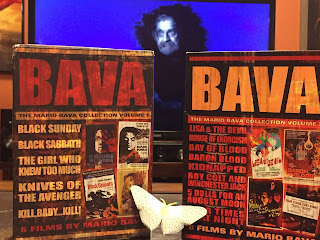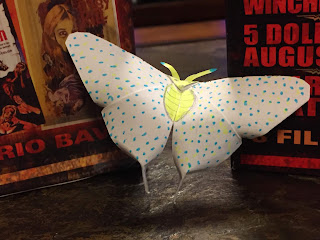One of my favorite moments in Rome promoting Sei Ancora Qui, the Italian language
version of I Still See You, the
stellar film based on my novel Break My
Heart 1,000 Times ,was a trip to Radio Rai to give an interview. Gabriel, the
publicist chaperoning Kim and I, let me know the interview would be live during our cab ride. This was only the second-most terrifying part, believe it or not. The most
terrifying part was that the show I’d be appearing on was focused on films and not books like I’d foolishly assumed. The Italian edition of Sei Ancora Qui was coming out later that week and, because I am often an idiot, I assumed that
people would be more interested in talking to me about that than the movie.
It has been a long, long time since I have been a movie
expert. My days of being an assistant manager/usher at a local megaplex are in
the distant past, and while I can speak definitively about the movies that came
out during those years, I haven’t kept up. Writing, day job, writing,
parenting, writing, reading--there hasn’t been nearly as much time for watching
films as I would like. I’ve read far more books than I’ve seen movies over the
past decade—hundreds of books; maybe three or four dozen movies. I try and keep
up with del Toro and the Coen brothers and a handful of others, but that’s
about it. My passive screen time has mostly been reserved for binge watching
multi-season television shows and NBA basketball. So when Gabriel said that the
interviewers would likely want me to talk about movies, I panicked. I felt like
my brain dumped its hard drive; I couldn’t even recall any of my favorite ghost
movies, which they would almost surely ask me about (The original Poltergeist, the original The Haunting based on Jackson’s The Haunting of Hill House, The Sixth Sense, and the remake of Thirteen Ghosts spring to mind. I hadn’t
even seen my own movie yet!
Gabriel led us through the security checkpoint, where we
admired the friendly guard’s origami handiwork, a collection of butterflies and
bugs lining his desk, and into the studio. I was in a cold sweat, literally,
when I sat down, and the interviewers started their show. It was amazing
watching and listening to them work; they clearly enjoyed their jobs and were bantering
back and forth in that delightful lyrical and physical cadence that characterizes
Italian conversation. I looked through the glass into the mixing room where my
wife and Gabriel sat with six or seven staff members, most of whom were
engrossed in watching a soccer game on a screen set on the opposite wall. I
smiled, weakly. No one wants to bomb in front of the woman they love, especially
me.
Then the questions started coming—in English, thank God—and the
main radio host had the unenviable task of translating my halting replies into
Italian and make me sound interesting. My intro was encouraging, and they
seemed to like my anecdote about wanting to write a “large-canvas ghost story”,
because most ghosts stories are “small in the sense of being confined to a
specific location, a haunted house or a church. I warmed up in talking about my
trip to Canada and watching Scott Speer, I
Still See You’s brilliant and tall director, encourage spectacular
performances from Bella, Richard, Shaun, Dermot and many others—in scenes that
scriptwriter Jason Fuchs had drawn directly from scenes I had written. Then
they asked me about my favorite films and film makers.
“Mario Bava,” I blurted, truthfully.
It turned out to be a great answer. The radio hosts both sighed and nodded
appreciatively, and Kim would tell me later that the tech staff in the booth stopped
watching the game for a moment and actually cheered my answer.
I really wasn’t pandering, although picking a native son
like Bava (Black Sabbath, Black Sunday, Lisa and the Devil, Bay of Blood, Shock, to drop a few of the English titles) certainly seems like an obsequious move in hindsight. I think he came to mind though
because when my mental hard drive crashed, taking with it most of my handy
responses, stories, and anecdotes, images remained. Images that I’d seen in the
trailers and bonus feature footage I’d seen of I Still See You.
Here’s the thing: the film looks gorgeous. It is wonderfully shot, framed—and this is
especially important when trying to trace down the synapse that led me to say “Bava”—stunningly
well lit. Every scene in Ronnie’s (oops, my Ronnie is Roni in the movie) house,
the scenes in the water, the scenes in the No-Go Zone, the icy expanses—the cinematography
is beautiful throughout and I feel especially fortunate that Simon Dennis
brought his genius to the film. I so wanted to ask him during the filming if Bava
had influenced him—the black and purples in the scenes with Brian, the amber
tone in the last scene of Ronnie’s house—but I never got the chance. I recently
watched Bava’s Black Sabbath for the
fortieth time recently and I’d be shocked if Mr. Dennis hadn’t studied and
loved Bava intensely, like I had.
Bava was a painter before he was a director, and that sensibility
carries over to the best of his films, which look painted with light. One of
the benefits in seeing Sei Ancora Qui before
seeing I Still See You, and not
speaking Italian, is that it allowed me to focus fully on the visuals and the
look of the film. It’s gorgeous, in my only slightly biased opinion, composed
with a similar painterly eye but enhanced by modern technique and technology.
In retrospect it is quite clear why I made the synaptic connection I did
between the I Still See You footage I’d
seen and Bava’s work.
We wrapped soon after my sound booth ovation. On the way
out, the mostly attentive guard had made a paper butterfly for Kim, one of the
greatest treasures from a trip filled with them. We thanked him, thanked
Gabriel, thanked everyone, and said our goodbyes. We had a movie to watch.















